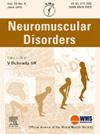慢性疼痛是异ferlin病的一个表现特征。
IF 2.7
4区 医学
Q2 CLINICAL NEUROLOGY
引用次数: 0
摘要
异常铁蛋白病是由编码异常铁蛋白的异常铁蛋白基因(DYSF)突变引起的,是临床上异质性的常染色体隐性肌营养不良症,其表型谱仍在进化中。在这里,我们描述了一个病人报告与体育锻炼无关的弥漫性肌肉疼痛,模仿纤维肌痛综合征。神经肌电图正常。骨骼肌磁共振成像(MRI)发现大内收肌、股内侧肌、腓肠肌外侧肌和内侧肌的t1加权脂肪替代和t2加权高强度和短tau倒置恢复(STIR)序列。免疫组化观察到三角肌活检组织中dysferlin表达明显降低,Western blot (WB)分析证实了这一点。基因检测证实诊断为异ferlinopathy与存在两个杂合变异体。我们报告一个新的临床表现与异常铁蛋白病的混淆特征,提出诊断困境和扩大临床谱异常铁蛋白肌病。本文章由计算机程序翻译,如有差异,请以英文原文为准。
Chronic pain as a presenting feature of dysferlinopathy
Dysferlinopathies, caused by mutations in the dysferlin gene (DYSF) encoding the dysferlin protein, are a clinically heterogeneous group of autosomal recessive muscular dystrophies whose phenotypic spectrum is still evolving. Here we described a patient reporting diffuse muscular pain non related to physical exercise, mimicking fibromyalgic syndrome. Electroneuromyography was normal. Magnetic resonance imaging (MRI) of skeletal muscles found fatty replacement on T1-weighted and hyperintensity on T2-weighted and short tau inversion recovery (STIR) sequences in the adductor magnus, the vastus medialis, the gastrocnemius lateralis and medialis. A significant decrease in dysferlin expression was observed by immunohistochemistry in the muscle biopsy from the deltoid, which was confirmed by Western blot (WB) analysis. Genetic testing confirmed the diagnosis of dysferlinopathy with the presence of two heterozygous variants. We report a new clinical presentation with confounding features for dysferlinopathy, posing a diagnostic dilemma and widening the clinical spectrum of dysferlin myopathies.
求助全文
通过发布文献求助,成功后即可免费获取论文全文。
去求助
来源期刊

Neuromuscular Disorders
医学-临床神经学
CiteScore
4.60
自引率
3.60%
发文量
543
审稿时长
53 days
期刊介绍:
This international, multidisciplinary journal covers all aspects of neuromuscular disorders in childhood and adult life (including the muscular dystrophies, spinal muscular atrophies, hereditary neuropathies, congenital myopathies, myasthenias, myotonic syndromes, metabolic myopathies and inflammatory myopathies).
The Editors welcome original articles from all areas of the field:
• Clinical aspects, such as new clinical entities, case studies of interest, treatment, management and rehabilitation (including biomechanics, orthotic design and surgery).
• Basic scientific studies of relevance to the clinical syndromes, including advances in the fields of molecular biology and genetics.
• Studies of animal models relevant to the human diseases.
The journal is aimed at a wide range of clinicians, pathologists, associated paramedical professionals and clinical and basic scientists with an interest in the study of neuromuscular disorders.
 求助内容:
求助内容: 应助结果提醒方式:
应助结果提醒方式:


